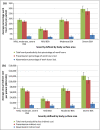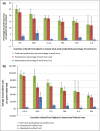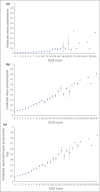A multinational assessment of work-related productivity loss and indirect costs from a survey of patients with psoriasis
- PMID: 31840228
- PMCID: PMC7497177
- DOI: 10.1111/bjd.18798
A multinational assessment of work-related productivity loss and indirect costs from a survey of patients with psoriasis
Abstract
Background: Total work productivity loss (WPL) and associated indirect costs contribute to the economic burden of psoriasis.
Objectives: To estimate total WPL and related indirect costs, and identify predictors of WPL associated with psoriasis severity in France, Germany, Spain, the U.K. and Italy (EU5) and the U.S.A.
Methods: Data from the 2015 Adelphi Real World Psoriasis Disease Specific Programme, analysed for absenteeism, presenteeism and total WPL, were quantified (0-100%) from participants who completed the Work Productivity and Activity Impairment (WPAI) instrument. These measures were converted to indirect costs using the human capital method. Univariate and multivariate statistical analyses controlling for patient demographic and clinical characteristics were conducted.
Results: Of the 936 respondents (29·6% U.S.A., 70·4% EU5) who completed the WPAI, 32·6%, 40·7% and 26·6% had mild [body surface area (BSA) 0-2%], moderate (BSA 3-10%) and severe (BSA > 10%) psoriasis, respectively. Average age, Dermatology Life Quality Index (DLQI) score and BSA were, respectively, 42·4 years, 5·1 and 9·6%; and 37·2% of respondents were female. Mean percentages of total WPL for respondents with mild, moderate and severe psoriasis were 10·1%, 18·9% and 29·4%, respectively. Presenteeism contributed considerably more to total WPL than did absenteeism across all countries and disease severity classes. Mean annual indirect costs per patient due to WPL ranged from 3742 U.S. dollars in Spain to 9591 U.S. dollars in the U.S.A. Multivariate regression showed that a one-unit increase in DLQI score increases total WPL by 1·8% (P < 0·001).
Conclusions: WPL increased progressively with increasing DLQI scores and BSA, confirming the relationship between psoriasis severity and its economic burden. What's already known about this topic? The economic burden of psoriasis is exceptionally high given the high prevalence and lifelong nature of the condition. Several studies have attempted to assess the overall economic burden of psoriasis but there is a lack of comparative data from different countries, and issues around inconsistent methodologies, including statistical analyses. Total work productivity loss (WPL) and associated indirect costs are believed to contribute to the economic burden of psoriasis. What does this study add? This study measured total WPL and indirect costs via the same method and at the same time point in the U.S.A., France, Germany, Spain, U.K. and Italy. Total WPL increased progressively with psoriasis disease severity. Disease severity and Dermatology Life Quality Index scores significantly correlated with WPL after controlling for patient demographic and clinical characteristics. The U.S.A. had the highest annual mean indirect costs associated with total WPL. Linked Comment: Drabo et al. Br J Dermatol 2020; 183:420-421.
© 2019 The Authors. British Journal of Dermatology published by John Wiley & Sons Ltd on behalf of British Association of Dermatologists.
Figures




Comment in
-
Yes, accurately measuring and valuing health-related productivity loss is important, but can we afford any longer not to prevent and address it?Br J Dermatol. 2020 Sep;183(3):420-421. doi: 10.1111/bjd.18904. Epub 2020 Mar 5. Br J Dermatol. 2020. PMID: 32141072 No abstract available.
References
-
- Lewis‐Beck C, Abouzaid S, Xie L et al Analysis of the relationship between psoriasis symptom severity and quality of life, work productivity, and activity impairment among patients with moderate‐to‐severe psoriasis using structural equation modeling. Patient Prefer Adherence 2013; 7:199–205. - PMC - PubMed
-
- World Health Organization . Global report on psoriasis. Geneva: World Health Organization, 2016. Available at: http://apps.who.int/iris/bitstream/10665/204417/1/9789241565189_eng.pdf (last accessed 26 December 2019).
-
- Vanderpuye‐Orgle J, Zhao Y, Lu J et al Evaluating the economic burden of psoriasis in the United States. J Am Acad Dermatol 2015; 72:961–7.e5. - PubMed
-
- Brezinski EA, Dhillon JS, Armstrong AW. Economic burden of psoriasis in the United States: a systematic review. JAMA Dermatol 2015; 151:651–8. - PubMed
Publication types
MeSH terms
Grants and funding
LinkOut - more resources
Full Text Sources
Medical

